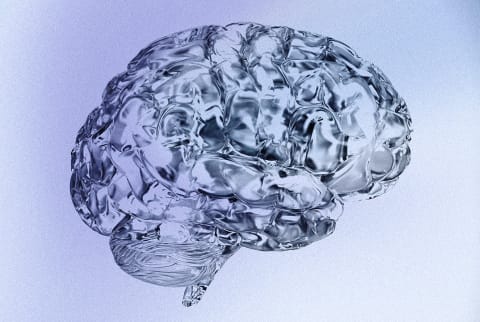Advertisement
What Brain Imaging Reveals About People With Suicidal Thoughts


Trigger warning: This article discusses suicide and suicidal ideation. People with suicidal thoughts can call the crisis lifeline and 988 to receive free support. Resources are also available on the Substance Abuse and Mental Health Services Administration (SAMHSA) website.
Why? It's the question that haunts us when a loved one dies by suicide or makes a suicide attempt. Sometimes, it seems like there are no warning signs, and people feel blindsided. And for the individuals who are in pain and have thoughts about ending their life, it's the unanswerable question.
Why do I feel like this?
Why can't I stop thinking this way?
Why can't I find a way out of the pain?
Suicide is highly complex, and there is no single or simple answer as to why some people become ensnared in suicidal thoughts and behaviors. But our brain imaging work at Amen Clinics reveals that at least part of the answer lies in the brain.
Suicide and the brain.
At Amen Clinics, we use a functional brain imaging technology called SPECT (single photon emission computed tomography) that measures blood flow and activity in the brain as part of a comprehensive psychiatric evaluation. SPECT provides valuable information about the brain, including areas with healthy blood flow and activity, areas that are overactive, and areas that are underactive.
We have performed brain scans on more than 300 people who have attempted suicide and on hundreds more who have had suicidal thoughts. The vast majority of these people share some combination of these characteristics:
- Negative thinking patterns
- Poor judgment
- Impulsivity
- Irritability or anger issues
What do the brain scans show?
People with suicidal thoughts and behaviors tend to have one or more of the following brain abnormalities:
Head trauma.
Damage to the brain due to one or more concussions or traumatic brain injuries (TBI)—even mild head injuries that aren't diagnosed and don't cause a blackout—is a common finding in suicidal people. A 2018 study in JAMA1 found that the risk of suicide triples in the first six months following a TBI, and it remains elevated long after that. Compared to those who have not had a head injury, people who have experienced a TBI are at a 75% increased risk for suicide seven years after experiencing an injury.
Car accidents, falls, sports injuries, and other incidents can damage the brain in ways that increase the risk of depression, anxiety, anger, impulsivity, poor decision-making, and substance abuse. All of these issues have been associated with a greater incidence of suicidality.
At Amen Clinics, SPECT scans show that an alarming 40% of patients have had a brain injury; however, the vast majority of them don't recall getting injured or don't think their injury was significant enough to mention. Most people never make the connection between a past head injury and mental health conditions or suicidal ideation.
Temporal lobe problems.
SPECT scans reveal that temporal lobe abnormalities are common in suicidal people. The temporal lobes, located underneath your temples and below your eyes, are involved in mood stability and temper issues, among other functions2. Trouble in the temporal lobes is associated with unstable moods, anger issues, dark thoughts, and violence.
An Amen Clinics study found problems with the left temporal lobe in 62% of individuals who had made a suicide attempt or who had suicidal thoughts.
Low activity in the prefrontal cortex.
The prefrontal cortex3 (PFC) is involved in impulse control, planning, judgment, and thinking about the consequences of one's actions. When there is low activity in this brain region, which is a common finding on SPECT scans of people with suicidal thoughts and behaviors, it leads to problems such as impulsivity, poor decision-making, and impaired judgment.
Overactive anterior cingulate gyrus.
The anterior cingulate gyrus5 (ACG) is the brain's gear shifter that allows you to go from one thought to another. Overactivity in this region is often seen on SPECT scans of people who have attempted suicide. When this area of the brain works too hard, people are more likely to get stuck on negative thoughts. Negative thinking patterns are one of the characteristics often seen in people with suicidal ideation. They become trapped in worries and negativity, which can make a person spiral downward.
How to optimize brain health to help prevent suicide.
Because brain dysfunction increases the risk of suicidal ideation, optimizing brain health is a critical component of suicide prevention. Here are some strategies to balance brain function:
- Head injuries: Neurofeedback and hyperbaric oxygen therapy (HBOT) promote healing after an injury. Nutraceuticals that support the brain's healing process include ginkgo biloba, acetyl-l-carnitine, huperzine-A, N-acetyl-cysteine, alpha-lipoic acid, and phosphatidylserine.
- Temporal lobes: Listening to classical music, chanting, dancing, and other forms of rhythmic movement can be healing. Nutraceuticals that may be beneficial include GABA, magnesium, and L-theanine.
- Prefrontal cortex: To boost blood flow to the PFC, engage in physical exercise and practice meditation. Nutritional supplements that support the PFC include rhodiola, ashwagandha, and green tea extract.
- Anterior cingulate gyrus: To get unstuck, notice when your negative thoughts are looping in your mind and distract yourself. To boost serotonin, which is often low in people with high ACG activity, consider taking the nutritional supplements saffron or 5-HTP or try one of these strategies.
The takeaway.
According to data from our brain clinic, people with suicidal ideation tend to have head trauma, temporal lobe abnormalities, low activity in the prefrontal cortex, and/or an overactive anterior cingulate gyrus. While there is no simple answer or cure for suicide, protecting these affected brain regions can be an essential part of suicide prevention.
People with suicidal thoughts can call the crisis lifeline and 988 to receive free support. Resources are also available on the Substance Abuse and Mental Health Services Administration (SAMHSA) website: https://www.samhsa.gov/.

















